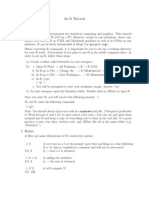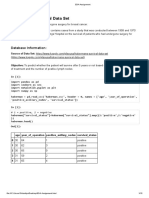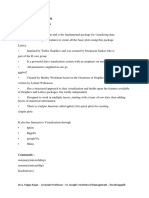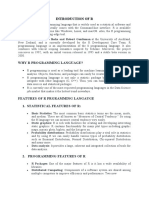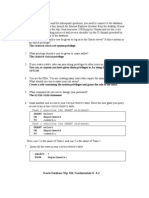R Short Tutorial
R Short Tutorial
Uploaded by
Pratiush TyagiCopyright:
Available Formats
R Short Tutorial
R Short Tutorial
Uploaded by
Pratiush TyagiCopyright
Available Formats
Share this document
Did you find this document useful?
Is this content inappropriate?
Copyright:
Available Formats
R Short Tutorial
R Short Tutorial
Uploaded by
Pratiush TyagiCopyright:
Available Formats
R Tutorial
Starting and Quitting R
Stat 698 Fall 2005
R is available on the following undergraduate machines: bacon, agnesi, fenchel, fitch, maddison, magnus, merrill, mgc2000 and in graduate machine beta. First login to this machine and to start R type the following at the UNIX prompt. bacon[101]% R To quit from R, type q()
Help Commands
You can type either of > help(log) > ?log To display the help file for the log (or any other) command. Type "help.start()" to start a help window. This is a way to list all the R commands and is very useful.
Simple Tasks in R
R is an interactive computing environment which you will use for data analysis. It can also be used as a calculator to perform simple tasks: > 4*6 [1] 24 > log(1000) [1] 6.907755
Creating Variables and Vectors
There are two assignment operators in R: <- and = They can be used interchangeably. > x <- 12 >x [1] 12 or x=12 (storing a scalar value)
> a <- c(1,2,3,4,5) >a [1] 1 2 3 4 5
(creating a five element vector)
> y <- 1:20 (creating a vector with the sequence of >y digits 1 through 20) [1] 1 2 3 4 5 6 7 8 9 10 11 12 13 14 15 16 17 18 19 20 > z <- seq(1,2,0.1) (using the seq command to modify the step >z value in a sequence) [1] 1.0 1.1 1.2 1.3 1.4 1.5 1.6 1.7 1.8 1.9 2.0 > z[5] [1] 1.4 (returns the 5th observation)
> z[-5] (return all observations except the 5th) [1] 1.0 1.1 1.2 1.3 1.5 1.6 1.7 1.8 1.9 2.0 > z[2:4] (return the 2nd, 3rd, and 4th observations)
Stat 698 Fall 2005 Operations on Vectors
Create two vectors x and y, having the same length and see what happens when you do each of the following operations >x+y >x-y > x / y #division element by element > x * y #multiplication element by element > sqrt(y) > x^3 > x^y > log(x) > cos(x)
Subsetting by Value
Sometimes you want to extract a subset of a vector based on its values. For instance, if you want to extract just those elements of that are less than 0, type > x=c(1,4,3,-2,-3,6,-5) > i=x<0 > x[i] This returns the vector [1] -2 -3 -5 A short cut is > x[x<0] see the output for x[x<6 & x>3]
Making a Matrix and Having Access to it
> b <- c(11,18,13,14,15) > A=cbind(a,b) >A A [1,] 1 11 [2,] 2 18 [3,] 3 13 [4,] 4 14 [5,] 5 15 > Y=matrix(1,2,3) >Y [,1] [,2] [,3] [1,] 1 1 1 [2,] 1 1 1 > A[3,2] [1] 13 > A[2,] [1] 2 12 > A[,2] [1] 11 12 13 14 15 (column binding) (There is also a command called rbind that will bind vectors together as the rows of a matrix)
(The first element is the data (can be a vector), the second is the number of rows and the third is the number of columns. Use help(matrix) for more information) (returns element at row 3, column 2) (returns the 2nd row) (returns the 2nd column)
Matrix Multiplication
> A%*%Y > S=matrix(1:4,2,2) > solve(S) (matrix multiplication) (inverse of the matrix a)
Stat 698 Fall 2005 Read a file : read.table("filepath")
The function read.table is very useful for reading data from an external ascii file into R and storing it in a data frame. For example, the following commands > data=read.table("abc.dat",header=T)
Probability functions
R has a family of probability functions for each of several distributions. For instance, for the normal distribution, there is rnorm, pnorm, qnorm, dnorm rnorm(10, 1, 2) generates 10 independent values from a normal distribution with mean 1 and standard deviation 2 > dnorm(1.5, 1, 2) (returns the value of the normal(1,2) pdf at x=1.5) > pnorm(1.5, 1, 2) (returns the value of the normal(1,2) cdf at x=1.5) > qnorm(0.2, 1, 2) (returns x such that P(X<=x) = 0.2 where X is a normal(1,2) random variable) Other distributions are chisq, f, t, binom, poisson, etc. The corresponding functions for the t distribution are rt, pt, qt, dt
How to Write your own functions
Apart from built in functions, you can write your own functions Example: standardize the observations > std=function(x){ + m=mean(x) + s=sqrt(var(x)) + result=(x-m)/s + return(result) +} Here, the function std takes an argument, vector x. The original vector is transformed by subtracting the mean and divide by the standard deviation. Create a new vector and try calling your function.
Simple Linear Regression
> > > > weight=c(45,60,45,65,80,77,55,70) height=c(5.5,6.0,4.5,5.5,6.5,6.5,5.5,6.0) reg=lm(height~weight) summary(reg)
Built-in functions
Some built-in R function can be viewed in the same way. Try looking at the functions hist, mean, quantile, sum, prod You can also use many predefined function in the following topic : regression, glm, ANOVA models, survival analysis, data analysis, bootstrap, experimental designs, calculus...Use the help menu (help.start()) for the exact syntax of the functions.
Iteration
Avoid iteration if you can; take advantage of R vectorized math and functions such as apply. It successively applies the function of your choice to each row (or column) of a matrix. Let's create a simple matrix and use apply to find the mean of each row/column. > x = matrix(1:12,3,4) > apply(x,2,mean) #returns the mean of each column. > apply(x,1,mean) #returns the mean of each row However sometimes iteration cannot be avoided. Then you can use the R commands for or while . Here is an example of using for inside a function
Stat 698 Fall 2005
jsum_function(x){ jsum <- 0 for(i in 1:length(x)) { jsum <- jsum + x[i]} return(jsum)} Note that R has it's own function that performs this task, called sum. It will work MUCH faster than this one, especially on large vectors.
Commands for Plotting
Before making any graphs in Unix Environment, you must open a graphics device. > motif() > dev.off() (open a graphic device) (close a graphic device)
The following commands will create a scatterplot of the height and weight data and add to is the regression (best-fit) line. > plot(weight,height,xlab="weight",ylab="height") > title("Plot of weight and height") > abline(reg) Other graphical functions include lines(), boxplot(), hist(). To control the layout and number of graphs put on one page (useful for reducing the number of pages you need to print for an assignment) use the mfrow argument in the function par(). Here well have two down and one across. > par(mfrow=c(2,1)) To save/print a plot in Windows, move the cursor to the figure, right click the mouse and choose the save as postscript /print option. To save a plot in Unix, you must use the following command before creating the plot: > postscript(filename)
Listing and Removing Objects from your Workspace
R saves all the objects (matrices, vectors etc.) you create. To save memory you will want to occasionally clean up your workspace. > ls() [1] "a" "x" "y" "z" > rm(x) (list all the objects in your workspace) (remove the object x)
Other Reminders: R is case sensitive be careful! Installing R on a Windows PC
R is a software environment for statistical analysis which is similar to S plus but free. If you want to download R and install it on a PC running Windows 95 or later: 1. Go to http://cran.us.r-project.org/ 2. Click on "Windows (95 and later)" under "Precompiled Binary Distributions". 3. In the subdirectory base/ you will find rw2011.exe. Download this self-installing binary to your machine, double-click it, and follow the instructions.
Stat 698: R Software Assignment
Stat 698 Fall 2005
NOTE: All students who are not exempted for R software must complete this assignment, which is due by Friday October 14, 2004. You may submit the completed assignment in class or put it in my mail box (Asokan Mulayath Variyath). You should submit a printout that shows the answers / plots to all the questions together with the R codes. (sofy copy submission via email not acceptable). If you need any help, please email. 1. Find a short way to calculate (a) 70! (b) product of integers from 21 to 50 (i.e multiply numbers 21, 22,,50) (hint: see the documentation for the function prod). 2. a) Generate a random sample of 10 observations from exponential distribution with =1 and store it in a vector named "expobs". Type the command set.seed(698) and enter, before genetating the random numbers. b) Use the rep function to create a new vector "newexpobs" that consists of the first value of "expobs" repeated 1 time, the second value of "expobs" repeated 2 times, the third value of "expobs" repeated 3 times, ..., the 10th value of "expobs" repeated 10 times. (Hint: Look at the documentation on rep). c) Calculate the mean, the standard deviation, the 25% quantile and the 75% quantile of your new data "newexpobs". 3. a) For this question, use data in the file nba.txt . The data are online at http://www.student.math.uwaterloo.ca/~stat698/stat698_09_05/nba.txt The first column of this dataset represents the id number of some basketball players. The second column represents their height (in inches) and the third one represents their weight (in pounds). Show how you can use the read.table function to read this data set into R. b) Identify all the players (by their number) whose height is >83 and weight is <=240. c) Using the above data, fit a linear regression model, height = 0 + 1 weight + d) Construct 90% confidence interval for the predicted value of mean height as well as predicted individual value of height the mean height when weight = 201, 220 and 245 pounds. (Hint: see the documentation for the command predict or predict.lm). e) Suppose that the first half of the players are women (number 1 to 205) and the second half are men. Plot height vs weight for men. ON THE SAME PLOT, plot height vs weight for women, but use a different plotting symbol (be sure they both have the same scale ). Add a legend on the plot and a title. Be sure to include a printout of your functions and the final plots. 4. Write a function that takes a single vector as argument, and returns the Hoteling's T2 statisitc,
! 2 1.5 0.5" # 3 0.8$ . Use this function to get T2 value T =(x ) (x-), where =(1.5, 3, 2) and = 1.5 # $ #0.5 0.8 4 $ % & for vectors (1,2,3), (1.2, 2.8, 2.3) and (2.3, 1.9, 4).
2 -1
You might also like
- Kruskal Wallis With RDocument4 pagesKruskal Wallis With RTria KartikaNo ratings yet
- An R Tutorial Starting OutDocument9 pagesAn R Tutorial Starting OutWendy WeiNo ratings yet
- Big Data File in RDocument23 pagesBig Data File in RPrabhu GoyalNo ratings yet
- Introduction To Data Science With R ProgrammingDocument91 pagesIntroduction To Data Science With R ProgrammingVimal KumarNo ratings yet
- STATS LAB Basics of R PDFDocument77 pagesSTATS LAB Basics of R PDFAnanthu SajithNo ratings yet
- Functions in R Sem-III 2021 PDFDocument30 pagesFunctions in R Sem-III 2021 PDFrajveer shah100% (1)
- R-Tutorial - IntroductionDocument30 pagesR-Tutorial - Introductionlamaram32No ratings yet
- R Basics PDFDocument10 pagesR Basics PDFSAILY JADHAVNo ratings yet
- Class 7Document42 pagesClass 7rishabhNo ratings yet
- Data Analysis Using R - 5Document9 pagesData Analysis Using R - 5harshvasudevkoliNo ratings yet
- Types of Distributions: Probablity Distribution (Non Specific) Binomial DistributionDocument1 pageTypes of Distributions: Probablity Distribution (Non Specific) Binomial DistributionhellokeetyNo ratings yet
- R ProgrammingDocument63 pagesR ProgrammingruthlaracastNo ratings yet
- R Basics NotesDocument15 pagesR Basics NotesGrowii GrowiiNo ratings yet
- Organizing Visualizing and Describing DataDocument35 pagesOrganizing Visualizing and Describing DataFenil RamaniNo ratings yet
- EDA AssignmentDocument15 pagesEDA AssignmentdegaciNo ratings yet
- Predictive Modeling Project ReportDocument31 pagesPredictive Modeling Project ReportArchana shukla100% (2)
- R Assignment FinalDocument30 pagesR Assignment Finalvaibhav solankiNo ratings yet
- Rmarkdown Cheatsheet 2.0 PDFDocument2 pagesRmarkdown Cheatsheet 2.0 PDFAnto PadaunanNo ratings yet
- R Handout Statistics and Data Analysis Using RDocument91 pagesR Handout Statistics and Data Analysis Using Rtele6No ratings yet
- 3.exponential Family & Point Estimation - 552Document33 pages3.exponential Family & Point Estimation - 552Alfian Syamsurizal0% (1)
- Dplyr TutorialDocument22 pagesDplyr TutorialDamini Kapoor100% (1)
- Statistics For BegineersDocument28 pagesStatistics For BegineersAditya GoleNo ratings yet
- Data Visualization in R Sem-III 2021 PDFDocument57 pagesData Visualization in R Sem-III 2021 PDFrajveer shahNo ratings yet
- Python Data Science AssignmentDocument3 pagesPython Data Science AssignmentMo ShahNo ratings yet
- Introduction To R: Arin Basu MD MPH DataanalyticsDocument33 pagesIntroduction To R: Arin Basu MD MPH DataanalyticsANo ratings yet
- Discrete Data Is A Count That Involves Integers. Only A Limited Number ofDocument3 pagesDiscrete Data Is A Count That Involves Integers. Only A Limited Number ofAlok ThakurNo ratings yet
- SAS PresentationDocument49 pagesSAS PresentationVarun JainNo ratings yet
- Statistical Computing by Using RDocument11 pagesStatistical Computing by Using RChen-Pan Liao100% (1)
- 100 Data Science in R Interview Questions and Answers For 2016Document56 pages100 Data Science in R Interview Questions and Answers For 2016Tata Sairamesh100% (2)
- Random ForestDocument2 pagesRandom Forestsanthi s0% (1)
- Excel - Module 2 (Formulas, Functions, and Formatting)Document3 pagesExcel - Module 2 (Formulas, Functions, and Formatting)Carl Dhaniel Garcia SalenNo ratings yet
- My ML Lab ManualDocument21 pagesMy ML Lab ManualAnonymous qZP5Zyb2No ratings yet
- R Programming IntroductionDocument20 pagesR Programming Introductionkeerthan reddyNo ratings yet
- Data Visualization Using RDocument26 pagesData Visualization Using Rshiva shangariNo ratings yet
- Goodness of Fit Negative Binomial RDocument3 pagesGoodness of Fit Negative Binomial RTimothyNo ratings yet
- MongoDB CheatSheetDocument9 pagesMongoDB CheatSheetRahul KumarNo ratings yet
- RSTUDIODocument44 pagesRSTUDIOsamarth agarwalNo ratings yet
- 4 Hypothesis Testing in The Multiple Regression ModelDocument49 pages4 Hypothesis Testing in The Multiple Regression ModelAbhishek RamNo ratings yet
- Linear Regression Chap01Document7 pagesLinear Regression Chap01israel14548100% (1)
- Central Limit TheoremDocument3 pagesCentral Limit Theoremarvindshukla123No ratings yet
- Rmarkdown Cheatsheet 2.0Document2 pagesRmarkdown Cheatsheet 2.0Weid Davinio PanDuroNo ratings yet
- Stat Term PaperDocument17 pagesStat Term PaperFahimAnwarNo ratings yet
- Introduction To Rstudio: Creating VectorsDocument11 pagesIntroduction To Rstudio: Creating VectorsMandeep SinghNo ratings yet
- The Next Level of Data Visualization in PythonDocument17 pagesThe Next Level of Data Visualization in PythonNiranjan ReddyNo ratings yet
- RDataMining Slides Text MiningDocument34 pagesRDataMining Slides Text MiningSukhendra SinghNo ratings yet
- CS2610 Final Exam: If Is - Nan PrintDocument5 pagesCS2610 Final Exam: If Is - Nan PrintAneudy MNo ratings yet
- An Introduction To R LanguageDocument11 pagesAn Introduction To R Languagetheodor_munteanuNo ratings yet
- Regression - Elements of AI 4-2Document20 pagesRegression - Elements of AI 4-2Mubasher Hussain100% (2)
- R - Tutorial: Matrices Are VectorsDocument13 pagesR - Tutorial: Matrices Are VectorsИван РадоновNo ratings yet
- R Lab File DeepakDocument27 pagesR Lab File Deepakparv saxenaNo ratings yet
- StatisticsDocument72 pagesStatisticsAvinash Sharma100% (1)
- Financial Analytics With PythonDocument40 pagesFinancial Analytics With PythonHarshit Singh100% (1)
- Advanced StatisticsDocument6 pagesAdvanced StatisticsParakokwaNo ratings yet
- Unit3 160420200647 PDFDocument146 pagesUnit3 160420200647 PDFArunkumar GopuNo ratings yet
- SQL Fundamentals II - Practice SolutionsDocument25 pagesSQL Fundamentals II - Practice SolutionsНЛесс33% (3)
- R Programming TutorialDocument8 pagesR Programming TutorialgunthejaganNo ratings yet
- Math10282 Ex03 - An R SessionDocument10 pagesMath10282 Ex03 - An R SessiondeimanteNo ratings yet
- R IntroductionDocument40 pagesR IntroductionSEbastian CardozoNo ratings yet
- SEC NotesDocument62 pagesSEC NotesabcNo ratings yet
- Session Set Working Directory Choose DirectlryDocument17 pagesSession Set Working Directory Choose DirectlryAnimesh DubeyNo ratings yet

